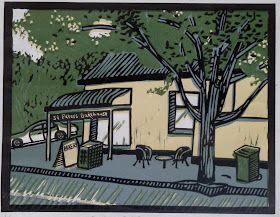One of my favourite printmaking processes is lino printing. Lino printing (sometimes known more broadly as relief printing) is a reductive method. I begin with a flat piece of linoleum, then use special tools to carve out certain areas. When I have finished carving, I use a roller to roll ink over the surface. The ink sits on the surface, but doesn't go into the grooves created by the carving. I then place paper on top, and either run it through a printing press or print by hand, pressing down on the back of the paper until all the ink has transferred. One of my favourite moments in printing is peeling back the paper and seeing the image for the first time...voila!
The three images below are all created using lino, with varying outcomes.
 |
| The Wild Woods, 2011 Linocut (edition of 4) |
In The Wild Woods the white areas have been carved out, and the remaining surface area inked up with black ink and printed.
 |
| Scarecrow in Field, 2011 Handcoloured linocut (uneditioned) |
The above image was printed using black ink, then I added the colour using watercolour paint.
 |
| St Peters Bakehouse, 2011 Multiplate reduction linocut (edition of 4) |
St Peters Bakehouse was a little more complicated to do, utilizing two separate lino blocks and four different colours. This method is called a reduction print, as I used the same block of lino to print the grey, beige and green.
I started by carving out all the areas that would be white, then inked up the entire block and printed it in beige. I then took the same block and carved out everything that I wanted to keep beige, and printed the second layer in green. Carving out everything I wanted to keep green, I printed the third layer in grey. The fourth and final layer was printed in black using a second lino block (called the key block as it ties the whole image together).
This method can be tricky as essentially you are burning your bridges as you go. No coming back at a later date and re-printing the edition! When I use this method I always make sure I print more than I need in the edition, as it is also very easy to mis-register one of the layers and stuff the entire print up. Although some slippage can make the print look more lively, too much and you risk looking like you can't register at all!
Coincidentally, St Peters Bakehouse also serves the best coffee scrolls in town.

No comments:
Post a Comment